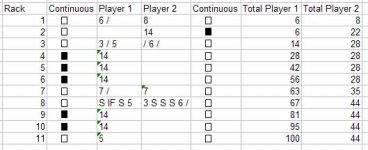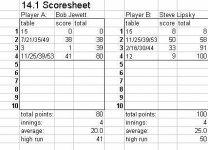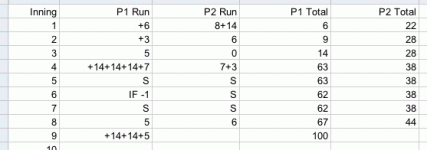Here is a score sheet that keeps score something like the counters over the table. The number of balls made in each rack is entered as a separate number in the “R” column.
The balls on the table = 15- the last entry in the “R” column.
The sum of the "R" scores is the score for the inning and may or not be accompanied by an "S" for safe.
An uncalled "safe" is here defined as any shot that is not called and does not have an obvious line to a pocket.
The penalty column is used to enter the penalty subtracted from the total score.
Total is the sum of the score column entries minus any penaties for that inning.

If the player runs multiple racks, the first score in "R" keps the rack right, check marks indicate 14 balls or the whole rack, the last entry is needed to keep the rack right. so an entry like 2 x x x x x 11 means the player ran 83 balls and there are four balls left on the table.
bpi= sum of inning except (0s) / number of these innings.
%safe = Sum of S / total innings
Created by Joe W and placed in the public domain for anyone to use at any time -- enjoy.
The balls on the table = 15- the last entry in the “R” column.
The sum of the "R" scores is the score for the inning and may or not be accompanied by an "S" for safe.
An uncalled "safe" is here defined as any shot that is not called and does not have an obvious line to a pocket.
The penalty column is used to enter the penalty subtracted from the total score.
Total is the sum of the score column entries minus any penaties for that inning.

If the player runs multiple racks, the first score in "R" keps the rack right, check marks indicate 14 balls or the whole rack, the last entry is needed to keep the rack right. so an entry like 2 x x x x x 11 means the player ran 83 balls and there are four balls left on the table.
bpi= sum of inning except (0s) / number of these innings.
%safe = Sum of S / total innings
Created by Joe W and placed in the public domain for anyone to use at any time -- enjoy.
Last edited:




